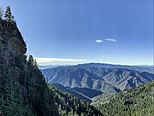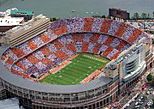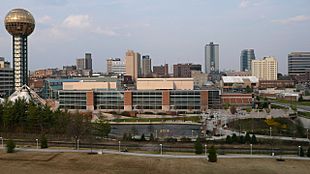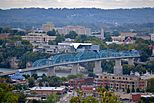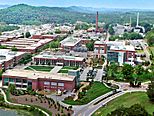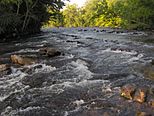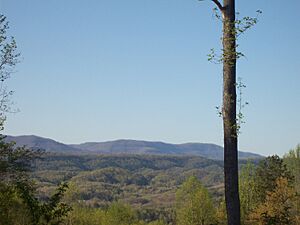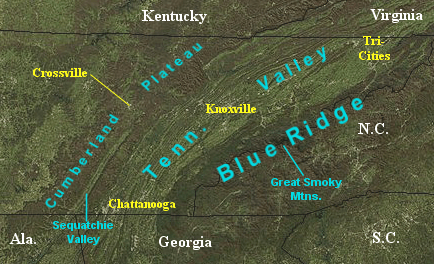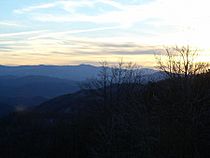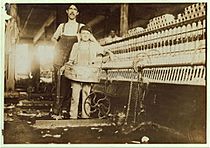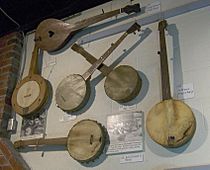East Tennessee facts for kids
Quick facts for kids
East Tennessee
|
|
|---|---|
|
Grand Division
|
|
|
From top (left to right): Clingmans Dome in Great Smoky Mountains National Park, Neyland Stadium at the University of Tennessee, skyline of Knoxville, skyline of Chattanooga, Norris Dam and its reservoir, Oak Ridge National Laboratory, Sycamore Shoals State Historic Area
|
|
| Nickname(s):
East TN, East Tenn.
|
|

The counties of East Tennessee highlighted in red
|
|
| Country | |
| State | |
| Largest city | Knoxville |
| Area | |
| • Land | 35,115.8 km2 (13,558.27 sq mi) |
| Population
(2020)
|
2,470,105 |
| • Density | 70.34/km2 (182.18/sq mi) |
| Demonym(s) | East Tennessean |
East Tennessee is a special part of the state of Tennessee. It's one of three main areas called "Grand Divisions." This region is in the eastern third of Tennessee. It has 33 counties. Most of these counties are in the Eastern Time Zone.
East Tennessee is located entirely within the Appalachian Mountains. The land here changes a lot. You can find tall, forested mountains and wide river valleys. The biggest cities are Knoxville and Chattanooga. These are the third and fourth largest cities in Tennessee. The Tri-Cities area is also a major population center.
During the American Civil War, many people in East Tennessee stayed loyal to the Union. This was even though Tennessee joined the Confederacy. After the war, many factories and businesses started here. The Tennessee Valley Authority (TVA) was created in the 1930s. It helped the region grow and become more modern. Today, TVA's main offices are in Knoxville. Its power operations are in Chattanooga.
Oak Ridge was a very important place during World War II. Scientists there worked on making the first atomic bombs. These bombs helped end the war. East Tennessee is also a big part of Appalachia. It's home to the Great Smoky Mountains National Park, which is the most visited national park in the U.S. Many people think East Tennessee is where country music began. This was thanks to recording sessions in Bristol in 1927. The region has produced many famous musicians over the years.
Contents
Exploring East Tennessee's Landscape
East Tennessee is not just a geographical area. It also has a special legal meaning in Tennessee. It's one of the state's three "Grand Divisions." The state's highest court, the Tennessee Supreme Court, has rules about judges coming from each division. This helps make sure all parts of the state are fairly represented. The Supreme Court building for East Tennessee is in Knoxville.
What Does the Land Look Like?
East Tennessee has three main types of land. These are the Blue Ridge Mountains, the Ridge-and-Valley Appalachians (also called the "Tennessee Valley"), and the Cumberland Plateau.
The Blue Ridge Mountains are on the border with North Carolina. This area has the highest points in the state. This includes Clingmans Dome, which is Tennessee's tallest peak. The Blue Ridge area has several smaller mountain ranges. These include the Great Smoky Mountains. Most of the Blue Ridge is covered in thick forests. It is protected by parks like the Great Smoky Mountains National Park and the Cherokee National Forest.
The Ridge-and-Valley section is the largest part of the region. It's also where most people live. This area has long ridges and wide river valleys. The famous Tennessee River starts in Knoxville. It flows southwest through Chattanooga. Other important rivers here include the Holston and French Broad.
The Cumberland Plateau is a high, flat area. It rises about 1,000 feet (300 m) above the Tennessee Valley. It stretches from Cumberland Gap to the Alabama border. Some counties on the plateau are part of East Tennessee. These include Cumberland, Morgan, and Scott counties.
Counties of East Tennessee
East Tennessee is made up of 33 counties. Here are some of them:
Major Cities and Towns
The main cities in East Tennessee are Knoxville, Chattanooga, and the "Tri-Cities" area. The Tri-Cities include Bristol, Johnson City, and Kingsport.
The Blue Ridge mountain area is less populated. Its main towns are Elizabethton and Gatlinburg. In the Plateau region, Crossville is a well-known city.
Here are some cities and towns with more than 10,000 people:
- Knoxville (pop. 183,270)
- Chattanooga (pop. 173,366)
- Johnson City (pop. 65,123)
- Kingsport (pop. 52,962)
- Cleveland (pop. 42,774)
- Oak Ridge (pop. 27,387)
- Morristown (pop. 24,965)
- Bristol (pop. 24,821)
- Maryville (pop. 23,120)
- East Ridge (pop. 21,382)
- Farragut (pop. 17,720)
- Sevierville (pop. 16,011)
- Greeneville (pop. 15,020)
- Elizabethton (pop. 14,359)
- Athens (pop. 13,623)
- Red Bank (pop. 11,830)
- Soddy-Daisy (pop. 13,118)
People and Population
| Historical population | |||
|---|---|---|---|
| Census | Pop. | %± | |
| 1790 | 25,030 | — | |
| 1800 | 73,419 | 193.3% | |
| 1810 | 101,367 | 38.1% | |
| 1820 | 138,023 | 36.2% | |
| 1830 | 196,357 | 42.3% | |
| 1840 | 224,259 | 14.2% | |
| 1850 | 260,397 | 16.1% | |
| 1860 | 301,001 | 15.6% | |
| 1870 | 332,547 | 10.5% | |
| 1880 | 428,704 | 28.9% | |
| 1890 | 543,091 | 26.7% | |
| 1900 | 640,222 | 17.9% | |
| 1910 | 732,471 | 14.4% | |
| 1920 | 814,648 | 11.2% | |
| 1930 | 960,133 | 17.9% | |
| 1940 | 1,101,099 | 14.7% | |
| 1950 | 1,288,886 | 17.1% | |
| 1960 | 1,377,281 | 6.9% | |
| 1970 | 1,486,765 | 7.9% | |
| 1980 | 1,768,149 | 18.9% | |
| 1990 | 1,832,138 | 3.6% | |
| 2000 | 2,108,133 | 15.1% | |
| 2010 | 2,327,544 | 10.4% | |
| 2020 | 2,470,105 | 6.1% | |
| Source: 1910–2020 | |||
East Tennessee is the second most populated of the three Grand Divisions. In 2020, about 2.47 million people lived in its 33 counties. This was an increase of over 142,000 people since 2010.
Most people in East Tennessee are of White or European American background. In many counties, more people are of Hispanic or Latino origin than African American. This is different from some other parts of the Southeastern U.S. Larger African American populations live in Chattanooga and Knoxville.
Big Cities and Metro Areas
The main cities are Knoxville, Chattanooga, and the Tri-Cities. Knoxville is the third largest city in Tennessee. Its surrounding area has about 1 million people. Chattanooga is the fourth largest city. Its metro area has over 500,000 people. The Tri-Cities area is the third most populated in East Tennessee.
Most people in East Tennessee live in the Ridge-and-Valley region. This includes the major cities. Other important cities are Cleveland, Maryville, and Oak Ridge. The Blue Ridge area is less populated. Its main towns are Elizabethton and Gatlinburg.
Most people in East Tennessee drive cars to get around. There are not many other ways to travel, like trains or regional buses. People in the big cities usually spend about 23 minutes driving to work.
|
Largest cities or towns in East Tennessee
Source: |
||
|---|---|---|
| Rank | Pop. | |
| 1 | Knoxville | 190,740 |
| 2 | Chattanooga | 181,099 |
| 3 | Johnson City | 71,046 |
| 4 | Kingsport | 55,442 |
| 5 | Cleveland | 47,356 |
| 6 | Maryville | 31,907 |
| 7 | Oak Ridge | 31,402 |
| 8 | Morristown | 30,431 |
| 9 | Bristol | 27,147 |
| 10 | Farragut | 23,506 |
A Look Back at East Tennessee's History
Native American Heritage
We know a lot about the early Native Americans in East Tennessee. This is because of studies done when the TVA built dams. These studies showed that people lived here as early as 7,500 B.C. Later, during the Mississippian period (around 1000-1600 A.D.), people lived in farming communities. Spanish explorers like Hernando de Soto visited these communities in the 1500s.
By the late 1600s, the Cherokee tribe was the main group in the region. They had towns in the Little Tennessee and Hiwassee valleys. These were called the "Overhill towns." The Cherokee helped the British during the French and Indian War. This led to the building of Fort Loudoun in 1756. Over time, the Cherokee were forced to give up most of their lands. In 1838, many were sadly moved to Oklahoma on the Trail of Tears.
Early Settlers and New Governments
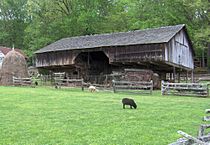
After the French and Indian War in 1763, many explorers came to East Tennessee. In 1769, William Bean built the first permanent European-American home in Tennessee. Soon after, James Robertson and others formed the Watauga settlement. In 1772, they created the Watauga Association. This was the first government west of the Appalachian Mountains.
During the American Revolution, the Wataugans helped fight the British. They sent 240 soldiers to the Battle of Kings Mountain. In the 1780s, people tried to form a new state called the State of Franklin. Its capital was in Jonesborough. But Congress never approved it. In 1790, the Southwest Territory was created. William Blount was its first governor. Knoxville became the capital of this territory. Most early settlers were of English or Scots-Irish background.
The Civil War and Its Impact
The Civil War was a very complicated time for East Tennessee. Many people in the region did not want to leave the Union. In February 1861, over 80% of East Tennesseans voted against leaving the Union. Even when the state voted to leave in June 1861, nearly 70% of East Tennesseans voted against it.
In June 1861, Union supporters met in Greeneville. They asked to form a separate state that would stay with the Union. But the state government said no. Confederate troops then took control of East Tennessee. Leaders like Senator Andrew Johnson asked President Abraham Lincoln to send Union troops. Lincoln made freeing East Tennessee a top goal. Union troops finally took control of Knoxville in late 1863. Chattanooga was also secured after important battles that year.
Growth and Industry After the War
After the Civil War, new businesses invested a lot in East Tennessee. This helped the economy recover. Cities like Knoxville and Chattanooga grew quickly. Many new factories were built. In 1899, the world's first Coca-Cola bottling plant opened in Chattanooga.
In the early 1900s, logging companies cut down many trees in the Great Smoky Mountains. The Burra Burra Mine was one of the biggest copper mines in the country. Coal mining also grew in the Cumberland Plateau. In the 1890s, a system where prisoners were forced to work led to a conflict called the Coal Creek War. This event helped end that system in Tennessee.
Big projects like the Ocoee Dam No. 1 and Hales Bar Dam were built. In the 1920s, Tennessee Eastman started in Kingsport. It became the state's largest employer. The Aluminum Company of America (ALCOA) built a huge aluminum factory in Alcoa in 1914. They also built dams to power it.
The Great Depression and World War II Changes
The Tennessee Valley Authority (TVA) was created in 1933 during the Great Depression. It changed East Tennessee a lot. TVA built many dams to control floods and provide cheap electricity. They also made the Tennessee River easier for boats to travel. Starting with Norris Dam in 1933, TVA built 10 dams in East Tennessee over 20 years.
East Tennessee was chosen for a top-secret project during World War II. This was the Manhattan Project, which built the atomic bomb. In 1942, the city of Oak Ridge was built. Work began on uranium enrichment facilities there. Other factories were built to make explosives and aluminum for the war effort. TVA also built dams very quickly to provide more electricity for these factories.
Music and Culture of East Tennessee
Appalachian music is a mix of different styles. It includes English and Scottish folk songs, Irish fiddle tunes, African-American blues, and religious music. In the early 1900s, a British expert named Cecil Sharp visited the region. He wrote down many old songs that had been passed down for generations. Early musicians like Uncle Am Stuart and Charlie Bowman became famous.
In 1927, the Victor Talking Machine Company held important recording sessions in Bristol. This is where Jimmie Rodgers and the Carter Family became well-known. These sessions helped start what we now call country music. Later, the Grand Ole Opry in Nashville became very popular. Many talented musicians from East Tennessee moved there.
Union County also played a big role in country music. Musicians like Roy Acuff, Chet Atkins, and Carl Smith were born there. They helped country music become popular around the world.
East Tennessee in Movies and TV
East Tennessee culture has been shown in many songs, TV shows, and movies. The Ford Show (1956-1961) was hosted by Tennessee Ernie Ford from Bristol. The 1990s TV show Christy was about village life in East Tennessee in the 1910s. It featured traditional mountain music. There's even a "ChristyFest" held every summer to celebrate the story.
The TV movie Dolly Parton's Coat of Many Colors aired in 2015. It was based on Dolly Parton's famous song and album. The movie tells the story of her childhood in the mountains of East Tennessee. Critics liked the film very much.
The folk hero Daniel Boone explored East Tennessee. He was honored in the theme song for the TV series Daniel Boone (1964-1970). The song "The Ballad of Davy Crockett" helped make the 1955 film Davy Crockett, King of the Wild Frontier popular. The song says Davy Crockett was "born on a mountaintop in Tennessee." His actual birthplace was in Limestone, Tennessee. Davy Crockett was a state lawmaker and Congressman for Tennessee.
Economy and Jobs in East Tennessee
For a long time, East Tennessee's economy relied on farming. But in cities, making goods in factories became very important. After the Civil War, Chattanooga became one of the first industrial cities in the South. Many factories were built in East Tennessee cities like Knoxville and Kingsport.
Businesses and Industries
Many big companies have their main offices in East Tennessee. These include Pilot Flying J and Regal Cinemas in Knoxville. BlueCross BlueShield of Tennessee and Unum are in Chattanooga. Eastman Chemical is in Kingsport.
East Tennessee makes many different products. These include chemicals, foods, car parts, and electronics. Eastman Chemical in Kingsport is the biggest manufacturer. It has over 10,000 employees. Volkswagen has a car factory in Chattanooga. Other companies like Denso make car parts here.
Many famous food and drink brands started in East Tennessee. These include Coca-Cola (first made in Chattanooga in 1899), Mayfield Dairy products, Moon Pie, Little Debbie, and Mountain Dew. East Tennessee is also a top place for making boats. Companies like Sea Ray and MasterCraft have factories here.
Oak Ridge National Laboratory (ORNL) and Y-12 National Security Complex in Oak Ridge are huge employers. ORNL does scientific research in many areas. It's the largest national laboratory in the U.S. Department of Energy system. The area between Oak Ridge and Knoxville is called the Tennessee Technology Corridor. It has over 500 high-tech companies. Chattanooga is also growing its tech and finance industries. It has very fast internet.
The town of Erwin has Nuclear Fuel Services. This company turns old weapons uranium into fuel for power plants. It's the biggest supplier of uranium fuel for the United States Navy.
Energy Production

The Tennessee Valley Authority (TVA) provides almost all of East Tennessee's electricity. TVA has its main offices in Knoxville. Its power operations are in Chattanooga. TVA runs nuclear power plants like Sequoyah and Watts Bar. It also operates coal-fired plants, natural gas plants, and many hydroelectric dams.
The two newest civilian nuclear power reactors in the U.S. are at the Watts Bar Nuclear Plant. Unit 2 started working in 2016. Scientists at Oak Ridge National Laboratory and TVA are studying new ways to use nuclear power.
Mining and Resources
East Tennessee has some of the largest zinc deposits in the United States. These are found in Jefferson, Grainger, and Hancock counties.
Tennessee marble is a special type of rock found only in East Tennessee. It looks like real marble when polished. It has been used in many famous buildings and monuments across the U.S. Knoxville became known as "The Marble City" because it was a center for cutting and selling this stone.
Tourism and Fun Things to Do
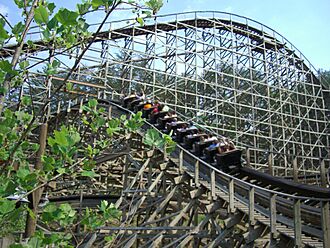
East Tennessee has always been a place for people to escape the summer heat. But its tourism industry really grew in the 1920s and 1930s. The Great Smoky Mountains National Park opened in 1934. This led to a huge tourism boom. Small towns like Gatlinburg and Pigeon Forge became popular resort towns. The Great Smoky Mountains National Park is the most visited national park in the U.S. It gets over 14 million visitors every year.
The park helps a huge tourism industry in nearby Gatlinburg, Pigeon Forge, and Sevierville. This is the third largest tourism industry in Tennessee. Fun attractions include Dollywood (the most visited ticketed attraction in Tennessee), Ober Gatlinburg, and Ripley's Aquarium of the Smokies.
Other fun places to visit include Big South Fork National River and Recreation Area and Cumberland Gap National Historical Park. The Appalachian Trail, a famous hiking trail, runs along the Tennessee-North Carolina border. The Cherokee National Forest protects many mountains in Tennessee. The Ocoee River is a very popular place for whitewater rafting. Many people also enjoy boating and fishing on lakes like Norris and Douglas.
In Chattanooga, you can visit the Tennessee Aquarium. It's one of the world's largest freshwater aquariums. You can also see Rock City and Ruby Falls on Lookout Mountain. Chattanooga has become a great place for outdoor sports. It has even been called the "Best Town Ever" by Outside magazine.
Getting Around East Tennessee
Roads and Highways
Interstate 75 (I-75) goes through Chattanooga and Knoxville. Interstate 40 (I-40) crosses the region from east to west, passing through Knoxville. I-40 and I-75 share the same road for about 20 miles (32 km) in Knoxville. This is the busiest road section in Tennessee. Interstate 81 (I-81) starts near Knoxville and goes northeast to Bristol. Interstate 26 (I-26) starts in Kingsport and goes south into North Carolina. Interstate 24 (I-24) ends in Chattanooga. It connects the region to Nashville.
Airports, Trains, and Waterways
Major airports in East Tennessee include McGhee Tyson Airport (TYS) near Knoxville. There's also Chattanooga Metropolitan Airport (CHA) and Tri-Cities Regional Airport (TRI). The Norfolk Southern Railway operates train lines in East Tennessee. The Tennessee River is the only navigable waterway in East Tennessee. Boats can travel through a system of locks at TVA dams.
Learning and Education
East Tennessee has many great colleges and universities. The main public universities are the Knoxville and Chattanooga campuses of the University of Tennessee. There's also East Tennessee State University in Johnson City.
Private colleges include Bryan College, Carson–Newman University, King University, and Lee University. There are also community colleges and technical schools. These include Pellissippi State Community College near Knoxville and Chattanooga State Community College.
The University of Tennessee's sports teams are called the "Volunteers" or "Vols." They are very popular in the region. The university's football team plays at Neyland Stadium. This is one of the largest stadiums in the country. The Thompson–Boling Arena hosts basketball games.


